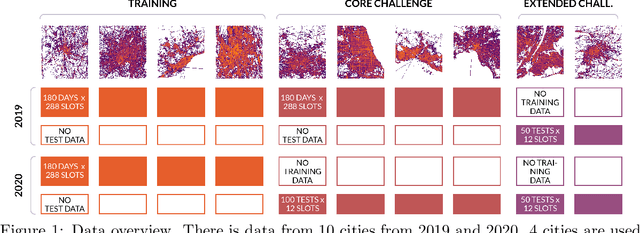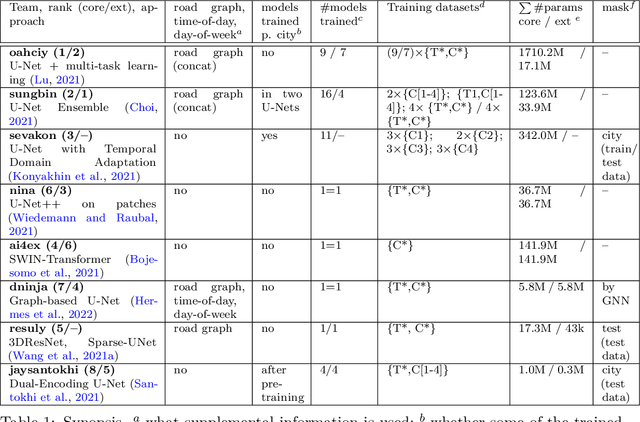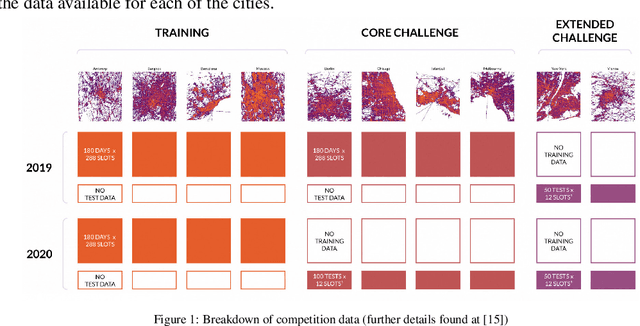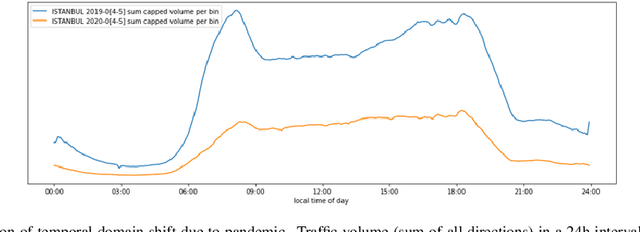Joned Sarwar
Traffic4cast at NeurIPS 2021 -- Temporal and Spatial Few-Shot Transfer Learning in Gridded Geo-Spatial Processes
Apr 01, 2022



Abstract:The IARAI Traffic4cast competitions at NeurIPS 2019 and 2020 showed that neural networks can successfully predict future traffic conditions 1 hour into the future on simply aggregated GPS probe data in time and space bins. We thus reinterpreted the challenge of forecasting traffic conditions as a movie completion task. U-Nets proved to be the winning architecture, demonstrating an ability to extract relevant features in this complex real-world geo-spatial process. Building on the previous competitions, Traffic4cast 2021 now focuses on the question of model robustness and generalizability across time and space. Moving from one city to an entirely different city, or moving from pre-COVID times to times after COVID hit the world thus introduces a clear domain shift. We thus, for the first time, release data featuring such domain shifts. The competition now covers ten cities over 2 years, providing data compiled from over 10^12 GPS probe data. Winning solutions captured traffic dynamics sufficiently well to even cope with these complex domain shifts. Surprisingly, this seemed to require only the previous 1h traffic dynamic history and static road graph as input.
Dual Encoding U-Net for Spatio-Temporal Domain Shift Frame Prediction
Oct 21, 2021



Abstract:The landscape of city-wide mobility behaviour has altered significantly over the past 18 months. The ability to make accurate and reliable predictions on such behaviour has likewise changed drastically with COVID-19 measures impacting how populations across the world interact with the different facets of mobility. This raises the question: "How does one use an abundance of pre-covid mobility data to make predictions on future behaviour in a present/post-covid environment?" This paper seeks to address this question by introducing an approach for traffic frame prediction using a lightweight Dual-Encoding U-Net built using only 12 Convolutional layers that incorporates a novel approach to skip-connections between Convolutional LSTM layers. This approach combined with an intuitive handling of training data can model both a temporal and spatio-temporal domain shift (gitlab.com/alchera/alchera-traffic4cast-2021).
Temporal Autoencoder with U-Net Style Skip-Connections for Frame Prediction
Nov 25, 2020



Abstract:Finding sustainable and novel solutions to predict city-wide mobility behaviour is an ever-growing problem given increased urban complexity and growing populations. This paper seeks to address this by describing a traffic frame prediction approach that uses Convolutional LSTMs to create a Temporal Autoencoder with U-Net style skip-connections that marry together recurrent and traditional computer vision techniques to capture spatio-temporal dependencies at different scales without losing topological details of a given city. Utilisation of Cyclical Learning Rates is also presented, improving training efficiency by achieving lower loss scores in fewer epochs than standard approaches.
 Add to Chrome
Add to Chrome Add to Firefox
Add to Firefox Add to Edge
Add to Edge